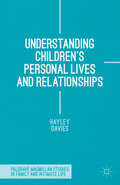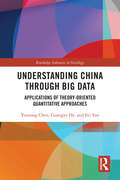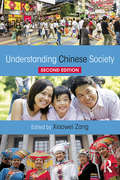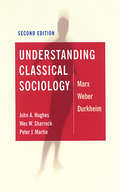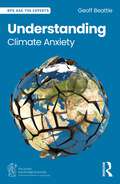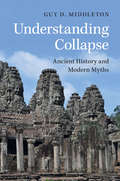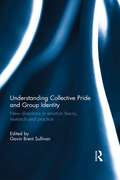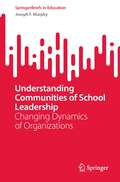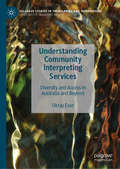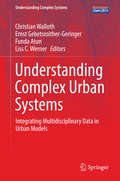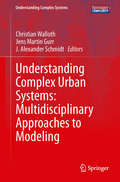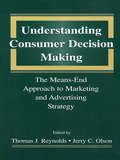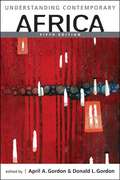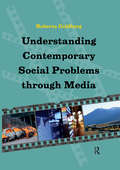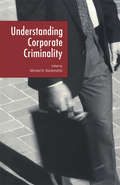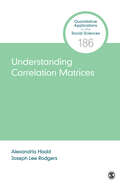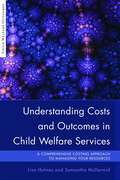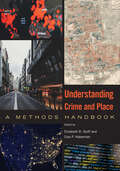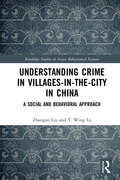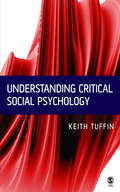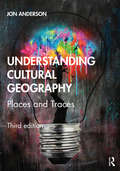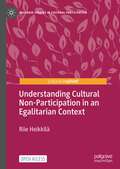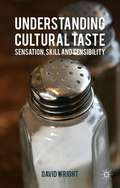- Table View
- List View
Understanding Children as Consumers (SAGE Advanced Marketing Series)
by Dr David W MarshallWhat drives children as consumers? How do advertising campaigns and branding effect children and young people? How do children themselves understand and evaluate these influences? Whether fashion, toys, food, branding, money - from TV adverts and the supermarket aisle, to the internet and peer trends, there is a growing presence of marketing forces directed at and influencing children and young people. How should these forces be understood, and what means of research or dialogue is required to assess them? With critical insight, the contributors to this collection, take up the evaluation of the child as an active consumer, and offer a valuable rethinking of the discussions and literature on the subject. Features: * 14 original chapters from leading researchers in the field * Each chapter contains vignettes or case examples to reinforce learning * Contains consideration of future research directions in each of the topics that the chapters cover. This book will be relevant reading for postgraduates and advanced undergraduates with an interest in children as consumers, consumer behaviour and on marketing courses in general as well as for researchers working in this field.
Understanding Children's Personal Lives and Relationships (Palgrave Macmillan Studies in Family and Intimate Life)
by Hayley DaviesInformed by ethnographic research with children, Davies offers new sociological insights into children's personal relationships, as well as closely examining methodological approaches to researching with children and researching relationships.
Understanding China through Big Data: Applications of Theory-oriented Quantitative Approaches (Routledge Advances in Sociology)
by Fei Yan Yunsong Chen Guangye HeChen, He and Yan present a range of applications of multiple-source big data to core areas of contemporary sociology, demonstrating how a theory-guided approach to macrosociology can help to understand social change in China, especially where traditional approaches are limited by constrained and biased data. In each chapter of the book, the authors highlight an application of theory-guided macrosociology that has the potential to reinvigorate an ambitious, open-minded and bold approach to sociological research. These include social stratification, social networks, medical care, and online behaviours among many others. This research approach focuses on macro-level social process and phenomena by using quantitative models to statistically test for associations and causalities suggested by a clearly hypothesised social theory. By deploying theory-oriented macrosociology where it can best assure macro-level robustness and reliability, big data applications can be more relevant to and guided by social theory. An essential read for sociologists with an interest in quantitative and macro-scale research methods, which also provides fascinating insights into Chinese society as a demonstration of the utility of its methodology.
Understanding Chinese Society
by Xiaowei ZangThis second edition of Understanding Chinese Society provides a comprehensive, readable, and well-grounded introduction to the key issues affecting contemporary China. A thorough analysis is undertaken not only of China’s family patterns, education system, status, hierarchy, and ethnic diversity, but also of China’s mass media, legal system and social control, work, and cultural expression. As well as being thoroughly updated and revised throughout, this edition offers new chapters on urbanization, the environment, and civil society in China. A team of international experts guide students though social issues including: What are the key features of the family and marriage institutions in China? How are women and men faring differently in Chinese society today? How are minorities faring in China? How does the education system differentiate Chinese society? How are religion and cultural traditions expressed? Including handy pedagogical features such as a chronology of the People's Republic of China, further reading suggestions, and related novels and films, Understanding Chinese Society is suitable for anyone studying Chinese Culture and Society, Chinese Studies and Asian sociology.
Understanding Classical Sociology: Marx, Weber, Durkheim
by Peter J. Martin Wes Sharrock John HughesPraise for the First Edition: `Totally reliable... the authors have produced a book urgently needed by all those charged with introducing students to the classics... quite indispensable' - Times Higher Education Supplement This is a fully updated and expanded new edition of the successful undergraduate text. Providing a lucid examination of the pivotal theories of Marx, Durkheim and Weber, the authors submit that these figures have decisively shaped the discipline. They show how the classical apparatus is in use, even though it is being directed in new ways in response to the changing character of society. Written with the needs of undergraduates in mind, the text is essential reading for students in sociology and social theory.
Understanding Climate Anxiety (BPS Ask The Experts in Psychology Series)
by Geoff BeattieHow should we react to climate anxiety? This accessible book discusses anxiety and other emotions brought on by climate change, examining what climate anxiety is, why it is becoming so prevalent and how it differs from other types of anxiety.Written by an expert psychologist, the book examines why climate anxiety is developing so rapidly, particularly in younger people. It looks at how it can manifest differently—sometimes as hopelessness or despair, and sometimes as anger which can serve as a catalyst for action. The book dives into the nuance around climate anxiety, questioning what we can do about it or whether climate anxiety should be pathologized at all, given the very real threat of climate change. It considers cognitive biases that underlie information processing and discusses how politics and interest groups affect people’s views. Seeking to understand the polarisation that occurs around this topic, the book suggests how we might alleviate climate anxiety without minimising serious concern about climate change.This highly topical book will be of great interest to students of psychology, environmental science and social science. It will also be of interest to psychologists, mental health professionals and climate communicators, as well as anyone interested in learning more about climate anxiety.
Understanding Collapse: Ancient History and Modern Myths
by Guy D. MiddletonUnderstanding Collapse explores the collapse of ancient civilisations, such as the Roman Empire, the Maya, and Easter Island. In this lively survey, Guy D. Middleton critically examines our ideas about collapse - how we explain it and how we have constructed potentially misleading myths around collapses - showing how and why collapse of societies was a much more complex phenomenon than is often admitted. Rather than positing a single explanatory model of collapse - economic, social, or environmental - Middleton gives full consideration to the overlooked resilience in communities of ancient peoples and the choices that they made. He offers a fresh interpretation of collapse that will be accessible to both students and scholars. The book is an engaging, introductory-level survey of collapse in the archaeology/history literature, which will be ideal for use in courses on the collapse of civilizations, sustainability, and climate change. It includes up-to-date case studies of famous and less well-known examples of collapses, and is illustrated with 25 black and white illustrations, 3 line drawings, 16 tables and 18 maps.
Understanding Collective Pride and Group Identity: New directions in emotion theory, research and practice
by Gavin Brent SullivanCollective and group-based pride is currently covered across a number of disciplines including nationalism studies, sociology and social psychology, with little communication between fields. This multidisciplinary collection encourages interdisciplinary research and provides a unique insight into the subject, stemming from a psychological perspective. The collection builds upon insights from collective emotion research to consider the relations between collective pride, shame and guilt as well as emotions of anger, empowerment and defiance. Collective pride is examined in contexts that vary from small groups in relatively peaceful competition to protest movements and large groups in divisive conflicts. In the book collective pride is a complex and positive emotional experience evident in the behaviour of groups, that can lead to negative forms of collective hubris in which other groups are devalued or dominated. Emotions of Collective Pride and Group Identity brings together international contributors to discuss the theory, research and practice surrounding collective pride in relation to other emotions and collective, cultural and national identity. Divided into two parts, part one explores the philosophy and theory behind collective pride and its extremes. Part two draws upon the latest quantitative and qualitative empirical research to focus on specific issues, for example, happiness, national pride and the 2010 World Cup. Topics covered include: - cultural and national pride and identity - positive feelings of unity and solidarity- dynamic relationships between collective pride, guilt and shame- theories of emotions in ritual, symbolic and affective practices- collective pride and collective hubris in organizations- perspectives on national events from young people. This book will appeal to an interdisciplinary audience in the area of affect studies and emotion research including social psychologists, sociologists, historians and anthropologists.
Understanding Communities of School Leadership: Changing Dynamics of Organizations (SpringerBriefs in Education)
by Joseph F. MurphyThis book examines the evolution of schooling from bureaucracy and hierarchy to post-industrial schools, and places teachers’ leadership on center stage at the same time. That is, it asks teachers to deepen leadership in their classrooms and with other teachers. The book carries education and schooling from formal control to a social influence process and addresses the deeply rooted difficulty of focusing too much energy on content. It reveals the strong power of internal and external context and helps educators implant the idea of the school not as a fixed, immutable home, but as a relatively deep social process. It shows how co-leadership comes alive in schools. Communities of schooling is one of the three most critical developments in education in the last 140 years. When it is linked with the two other fundamental reorientations in schooling - “dispersed ownership” and “constructivist work” - it becomes the most powerful force in education since the 1700s. This book shows how communities of schooling replace the earlier pillars of “learning as telling,” “hierarchy of control,” and “non-democratic influence.” The work also explains the meaning and understanding of school work as a social influence process where all school-based educators exert power, but at different levels. The idea of enhancing individual and collective capacity through interdependency, shared work, and collective responsibility is unpacked.
Understanding Community Interpreting Services: Diversity and Access in Australia and Beyond (Palgrave Studies in Translating and Interpreting)
by Oktay EserThis book investigates community interpreting services as a market offering that satisfies the needs of Culturally and Linguistically Diverse (CALD) members of the Australian community, with an additional chapter on the Turkish context. Bringing together the disciplines of interpreting studies and management, the author analyses a variety of challenges which still arise in various fields of interpreting and suggest possible solutions, as well as future directions for other global contexts where changing demographics mean that community-based interpreting is increasingly relevant. Based on interviews with various stakeholders including directors, interpreters, and trainers in the private sector or state-run institutions, the book's main focus is the real experiences of people working on the ground in community interpreting. This book will be of interest to students and scholars of translation, interpreting and migration studies, as well as interpreters and their trainers, and government policy-makers.
Understanding Complex Urban Systems
by Christian Walloth Ernst Gebetsroither-Geringer Funda Atun Liss C. WernerUnderstanding Complex Urban Systems takes as its point of departure the insight that the challenges of global urbanization and the complexity of urban systems cannot be understood - let alone 'managed' - by sectoral and disciplinary approaches alone. But while there has recently been significant progress in broadening and refining the methodologies for the quantitative modeling of complex urban systems, in deepening the theoretical understanding of cities as complex systems, or in illuminating the implications for urban planning, there is still a lack of well-founded conceptual thinking on the methodological foundations and the strategies of modeling urban complexity across the disciplines. Bringing together experts from the fields of urban and spatial planning, ecology, urban geography, real estate analysis, organizational cybernetics, stochastic optimization, and literary studies, as well as specialists in various systems approaches and in transdisciplinary methodologies of urban analysis, the volume seeks to advance the discussion on multidisciplinary approaches to urban modeling. While engaging with the 'state of the art' in their respective fields, the contributions are specifically written for both experts from a broad range of disciplines as well as for urban practitioners who feel the need for new approaches given the uncertainty of current developments.
Understanding Complex Urban Systems: Multidisciplinary Approaches to Modeling
by Christian Walloth Jens Martin Gurr J. Alexander SchmidtUnderstanding Complex Urban Systems takes as its point of departure the insight that the challenges of global urbanization and the complexity of urban systems cannot be understood - let alone 'managed' - by sectoral and disciplinary approaches alone. But while there has recently been significant progress in broadening and refining the methodologies for the quantitative modeling of complex urban systems, in deepening the theoretical understanding of cities as complex systems, or in illuminating the implications for urban planning, there is still a lack of well-founded conceptual thinking on the methodological foundations and the strategies of modeling urban complexity across the disciplines. Bringing together experts from the fields of urban and spatial planning, ecology, urban geography, real estate analysis, organizational cybernetics, stochastic optimization, and literary studies, as well as specialists in various systems approaches and in transdisciplinary methodologies of urban analysis, the volume seeks to advance the discussion on multidisciplinary approaches to urban modeling. While engaging with the 'state of the art' in their respective fields, the contributions are specifically written for both experts from a broad range of disciplines as well as for urban practitioners who feel the need for new approaches given the uncertainty of current developments.
Understanding Consumer Decision Making: The Means-end Approach To Marketing and Advertising Strategy
by Thomas J. Reynolds Jerry C. OlsonThe goal of this book is to help business managers and academic researchers understand the means-end perspective and the methods by which it is used, and to demonstrate how to use the means-end approach to develop better marketing and advertising strategy. The authors discuss methodological issues regarding interviewing and coding, present applications of the means-end approach to marketing and advertising problems, and describe the conceptual foundations of the means-end approach. This book is of interest to academic researchers in marketing and related fields, graduate students in business, marketing research professionals, and business managers. It is intended as a reference book containing ideas about the means-end approach and its applications.
Understanding Contemporary Africa (Understanding: Introductions to the States and Regions of the Contemporary World)
by April A. Gordon Donald L. GordonThis new edition of Understanding Contemporary Africa has been thoroughly revised to reflect the many significant events and trends of the past six years-seismic political changes, the impact of the new information technology, the strong presence of China and other foreign powers, and much more. The authors provide current analyses not only of history, politics, and economics, but also geography, environmental concerns, population shifts, and social and cultural issues. Each topic is covered in an accessible style, but with reference to the latest scholarship. Maps, photographs, and a table of basic political data enhance the text.
Understanding Contemporary Social Problems Through Media
by Roberta GoldbergGoldberg uses a multi-media approach to critically examine the most significant and volatile issues of our times: the environmental crisis, upheavals in the developing world, health, terrorism, and technology. The book is unique in its in-depth coverage of these pressing social concerns and its use of extensive media resources through a companion website. An introductory section reviews basic sociological concepts and theories, including the sociological imagination and class, gender, and race stratification all of which are revisited in each chapter. The book helps students appreciate the magnitude of the problems of the twenty-first century as they develop the intellectual tools to understand them sociologically and personally.Features of the text: "
Understanding Corporate Criminality (Current Issues in Criminal Justice #Vol. 3)
by Michael B. BlankenshipFirst Published in 1995. Routledge is an imprint of Taylor & Francis, an informa company.
Understanding Correlation Matrices (Quantitative Applications in the Social Sciences)
by Joseph Lee Rodgers Alexandria R. HaddCorrelation matrices (along with their unstandardized counterparts, covariance matrices) underlie the majority the statistical methods that researchers use today. A correlation matrix is more than a matrix filled with correlation coefficients. The value of one correlation in the matrix puts constraints on the values of the others, and the multivariate implications of this statement is a major theme of the volume. Alexandria Hadd and Joseph Lee Rodgers cover many features of correlations matrices including statistical hypothesis tests, their role in factor analysis and structural equation modeling, and graphical approaches. They illustrate the discussion with a wide range of lively examples including correlations between intelligence measured at different ages through adolescence; correlations between country characteristics such as public health expenditures, health life expectancy, and adult mortality; correlations between well-being and state-level vital statistics; correlations between the racial composition of cities and professional sports teams; and correlations between childbearing intentions and childbearing outcomes over the reproductive life course. This volume may be used effectively across a number of disciplines in both undergraduate and graduate statistics classrooms, and also in the research laboratory.
Understanding Correlation Matrices (Quantitative Applications in the Social Sciences)
by Joseph Lee Rodgers Alexandria R. HaddCorrelation matrices (along with their unstandardized counterparts, covariance matrices) underlie the majority the statistical methods that researchers use today. A correlation matrix is more than a matrix filled with correlation coefficients. The value of one correlation in the matrix puts constraints on the values of the others, and the multivariate implications of this statement is a major theme of the volume. Alexandria Hadd and Joseph Lee Rodgers cover many features of correlations matrices including statistical hypothesis tests, their role in factor analysis and structural equation modeling, and graphical approaches. They illustrate the discussion with a wide range of lively examples including correlations between intelligence measured at different ages through adolescence; correlations between country characteristics such as public health expenditures, health life expectancy, and adult mortality; correlations between well-being and state-level vital statistics; correlations between the racial composition of cities and professional sports teams; and correlations between childbearing intentions and childbearing outcomes over the reproductive life course. This volume may be used effectively across a number of disciplines in both undergraduate and graduate statistics classrooms, and also in the research laboratory.
Understanding Crime and Place: A Methods Handbook
by Elizabeth R. Groff and Cory P. HabermanPlace has become both a major field of criminological study as well as an important area for policy development. Capturing state of the art crime and place research methods and analysis, Understanding Crime and Place is a comprehensive Handbook focused on the specific skills researchers need. The editors and contributors are scholars who have been fundamental in introducing or developing a particular method for crime and place research. Understanding Crime and Place is organized around the scientific process, introducing major crime and place theories and concepts, discussions of data and data collection, core spatial data concepts, as well as statistical and computational techniques for analyzing spatial data and place-based evaluation. The lessons in the book are supplemented by additional instructions, examples, problems, and datasets available for download. Conducting place-based research is an emerging field that requires a wide range of cutting-edge methods and analysis techniques that are only beginning to be widely taught in criminology. Understanding Crime and Place bridges that gap, formalizes the discipline, and promotes an even greater use of place-based research. Contributors: Martin A. Andresen, Matthew P J Ashby, Eric Beauregard, Wim Bernasco, Daniel Birks, Hervé Borrion, Kate Bowers, Anthony A. Braga, Tom Brenneman, David Buil-Gil, Meagan Cahill, Stefano Caneppele, Julien Chopin, Jeffrey E. Clutter, Toby Davies, Hashem Dehghanniri, Jillian Shafer Desmond, Beidi Dong, John E. Eck, Miriam Esteve, Timothy C. Hart, Georgia Hassall, David N. Hatten, Julie Hibdon, James Hunter, Shane D. Johnson, Samuel Langton, YongJei Lee, Ned Levine, Brian Lockwood, Dominique Lord, Nick Malleson, Dennis Mares, David Mazeika, Lorraine Mazerolle, Asier Moneva, Andrew Newton, Bradley J. O’Guinn, Ajima Olaghere, Graham C. Ousey, Ken Pease, Eric L. Piza, Jerry Ratcliffe, Caterina G. Roman, Stijn Ruiter, Reka Solymosi, Evan T. Sorg, Wouter Steenbeek, Hannah Steinman, Ralph B. Taylor, Marie Skubak Tillyer, Lisa Tompson, Brandon Turchan, David Weisburd, Brandon C. Welsh, Clair White, Douglas J. Wiebe, Pamela Wilcox, David B. Wilson, Alese Wooditch, Kathryn Wuschke, Sue-Ming Yang, and the editors.
Understanding Crime in Villages-in-the-City in China: A Social and Behavioral Approach (Routledge Studies in Asian Behavioural Sciences)
by T. Wing Lo Zhanguo LiuRapid urbanization of economic zones in China has resulted in a special social phenomenon: "villages-in-the-city." Underdeveloped villages are absorbed during the expansion of urban areas, while retaining their rustic characteristics. Due to the rural characteristics of these areas, social security is much lower compared with the urbanized city. This book uses Tang Village, a remote area in the Shenzhen Special Economic Zone, as an example to establish a comprehensive analytical framework by integrating existing crime theories in analyzing villages-in-the-city. The analysis covers the community, individual, and macro levels to detail the diverse social and behavioral factors causing crime at multiple levels. First, a brief history of the urbanization process of Tang Village is provided to establish how urban planning contributed to the issues in the village today. The authors go on to explain how socially disorganized communities dictate the crime hotspots and the common types of crime. The book examines other risk factors that may contribute to the level of crime such as weak social controls, building density, and floating populations of poor working-class migrants. The routine activities of victims, offenders, and guardians are examined. The book concludes with the current trends in the social structure within the villages-in-the-city and their expected outcome after urbanization.
Understanding Critical Social Psychology
by Keith Tuffin`This is a thoughtful, honest and accessible text which I would certainly recommend to students. The chapter ordering is excellent and should take the student through a logical progression from the more established to the more contemporary approaches in social psychology′ - Ian Hodges, Westminster University `It is written in a beautifully clear, engaging and conversational style which will make the book accessible and appealing to those encountering critical ideas for the first time.... Students will find the book both interesting and easy to read, and their lecturers will find it a valuable teaching resource. I will certainly be recommending it to my second and third year undergraduates′ - Viv Burr, University of Huddersfield Understanding Critical Social Psychology is an exciting new textbook providing a comprehensive and reader-friendly approach to the theories and methods surrounding Critical Social Psychology. For students taking a course in Critical Social Psychology, this book combines a critical examination of the traditional philosophies, practices and topics with an emphasis on introducing innovative and contemporary developments in social psychological research. In this way, Tuffin integrates newer insights with established modes of thinking. Key Features of this book include: " Student-friendly structure - contains numerous features suitable for undergraduate course use such as section summaries, further reading and a tutorial which answers students′ questions about critical social psychology. " Broad framework - Positions newer insights in relation to the historical, theoretical and ideological roots of social psychology. Ideal for students taking a Critical Social Psychology module having already studied a mainstream course. " Applied focus - Understanding Critical Social Psychology tackles key themes in the discipline i.e. prejudice, politics, identity and emotions from critical perspectives. Written in a clear and accessible style, with illustrative data, detailed chapter summaries and key readings at the end of each section, it will be welcomed by undergraduates seeking to develop their understanding of critical social psychology.
Understanding Cultural Geography: Places and Traces
by Jon AndersonThis book outlines how the theoretical ideas, empirical foci, and methodological techniques of cultural geography make sense of the ‘culture wars’ that define our time. It is on the battleground of culture that our opportunities, rights, and futures are determined and Understanding Cultural Geography showcases how this discipline can be used to understand these battles and how we can engage in them. Through doing so, the book not only introduces the reader to the rich and complex history of cultural geography, but also the key terms on which the discipline is built. From these insights, the text approaches place as an ‘ongoing composition of traces’, highlighting the dynamic and ever-changing nature of the world around us, and what our role can be in transforming it for the better. The third edition has been fully revised and updated to incorporate recent literature and reflect the changing cultural context of its time. Retaining its exciting and innovative structure, the third edition will expand its focus into new areas, including updated chapters on ethnicity and race, and new chapters on gender and the body. This new edition captures not only recent changes in the cultural world, but also the discipline itself, offering the most up-to-date text to understand and engage with the cultural battlegrounds which constitute our lives. Understanding Cultural Geography is the ideal text for students being introduced to the discipline through either undergraduate or postgraduate degree courses. The third edition is an important update to a highly successful text that incorporates a vast foundation of knowledge; it is an invaluable book for lecturers and students.
Understanding Cultural Non-Participation in an Egalitarian Context (Palgrave Studies in Cultural Participation)
by Riie HeikkiläThis book uses a rich data set, from individuals whose background profiles statistically predict strong cultural non-participation, to explore the most salient lifestyles and symbolic boundaries drawn in these potentially disengaged groups.The book departs from a theoretical framework in which cultural practices and cultural participation in their most visible and tangible form are seen as manifestations of cultural capital and power, to show empirically that people and groups dubbed passive in many policy documents and scholarly research are actually relatively active, both in terms of traditional cultural participation and different kinds of social and anthropological understandings of participation. This is an open access book.
Understanding Cultural Taste
by David WrightUnderstanding Cultural Taste updates and critiques established theoretical and empirical accounts of cultural taste. It considers the roles of the cultural industries and cultural policies in shaping tastes and the significance of the technologies through which cultural goods are produced and circulated. Taking a historical and theoretical perspective which complicates an understanding of taste as a matter of personal preference or a crude weapon in social struggles, the book argues that taste remains a key concept for the sociology of culture, media and cultural studies, cultural policy studies and their applied sub-disciplines. Such disciplines have come to appreciate the relation between taste and individual or group identities but have been less attentive to other social and political dimensions of this important component of cultural life.

